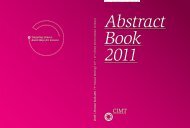Abstract Book 2010 - CIMT Annual Meeting
Abstract Book 2010 - CIMT Annual Meeting
Abstract Book 2010 - CIMT Annual Meeting
You also want an ePaper? Increase the reach of your titles
YUMPU automatically turns print PDFs into web optimized ePapers that Google loves.
029 Brix | Immune monitoring<br />
Culturing PBMC in the presence of antigen results in a measurable<br />
expansion of memory T cells<br />
Liselotte Brix, Tina Jakobsen, and Henrik Pedersen<br />
Immudex, Copenhagen, Denmark<br />
70<br />
Sensitive and reliable monitoring of cellular immune<br />
responses is becoming increasingly important in<br />
cancer vaccine and immunotherapeutic development.<br />
Flow analysis using conventional fluorescent<br />
MHC multimers like Tetramers and Pentamers has<br />
made a great impact in this field enabling visualization,<br />
enumeration and phenotypic characterization<br />
of antigen-specific T-cells. However, shortcomings<br />
such as difficulties in detecting low-affinity interactions,<br />
e.g. tumor-specific T-cell responses, low<br />
reproducibility and reagent stability are still prominent<br />
problems.<br />
MHC Dextramer reagents are a new generation of<br />
fluorescent MHC multimers that solve some of those<br />
problems. Thus, we have used MHC Dextramers to<br />
detect low-affinity T cells (i.e. T cells carrying TCR<br />
with low affinity for the MHC-peptide complex).<br />
In contrast to Tetramers, the Dextramers allowed<br />
enumeration of T cells carrying TCRs with a Kd of<br />
> 250 µM. To our knowledge this is the first time<br />
that antigen-specific T cells with such low-affinity<br />
TCR have been detected with a fluorescent MHC<br />
multimer reagent.<br />
When staining T cells of higher affinity-TCR’s (5<br />
µM – 100 µM), Dextramers had much higher resolution<br />
than the corresponding Tetramers. Dextramers<br />
thus provide a more reliable means for identification<br />
of true positive antigen-specific T cells.<br />
The increased sensitivity and resolution of the<br />
Dextramers probably reflects the higher number of<br />
MHC-peptide complexes and fluorochromes, since<br />
the high number of MHC-peptide complexes increases<br />
their avidity for the specific T-cells, and the<br />
higher number of fluorochromes enhances staining<br />
intensity. As a result, Dextramers have higher sensitivity,<br />
higher staining intensity and higher signalto-noise<br />
ratio.<br />
The dextran backbone of the MHC Dextramer<br />
stabilizes the attached proteins. When analyzing<br />
the stability of the MHC Dextramers, a given<br />
blood sample could be stained reproducibly well<br />
using the same batch of a MHC Dextramer for<br />
more than 4 month. Likewise, different batches<br />
of MHC Dextramers provided similar frequencies<br />
of antigen-specific T cells with comparable staining<br />
intensities when staining the same sample.<br />
We also investigated the impact of freezing and<br />
thawing MHC Dextramers. Surprisingly, the MHC<br />
Dextramer reagent could be subjected to repeated<br />
freeze-thaw cycles without affecting the staining<br />
intensity, resolution or the number of positive cells<br />
detected.<br />
In summary, MHC Dextramers are sensitive, highly<br />
stable reagents that are suitable to minimize assayto-assay<br />
variation, and that are particularly useful<br />
reagents in the immune monitoring of cancer immunotherapy.



